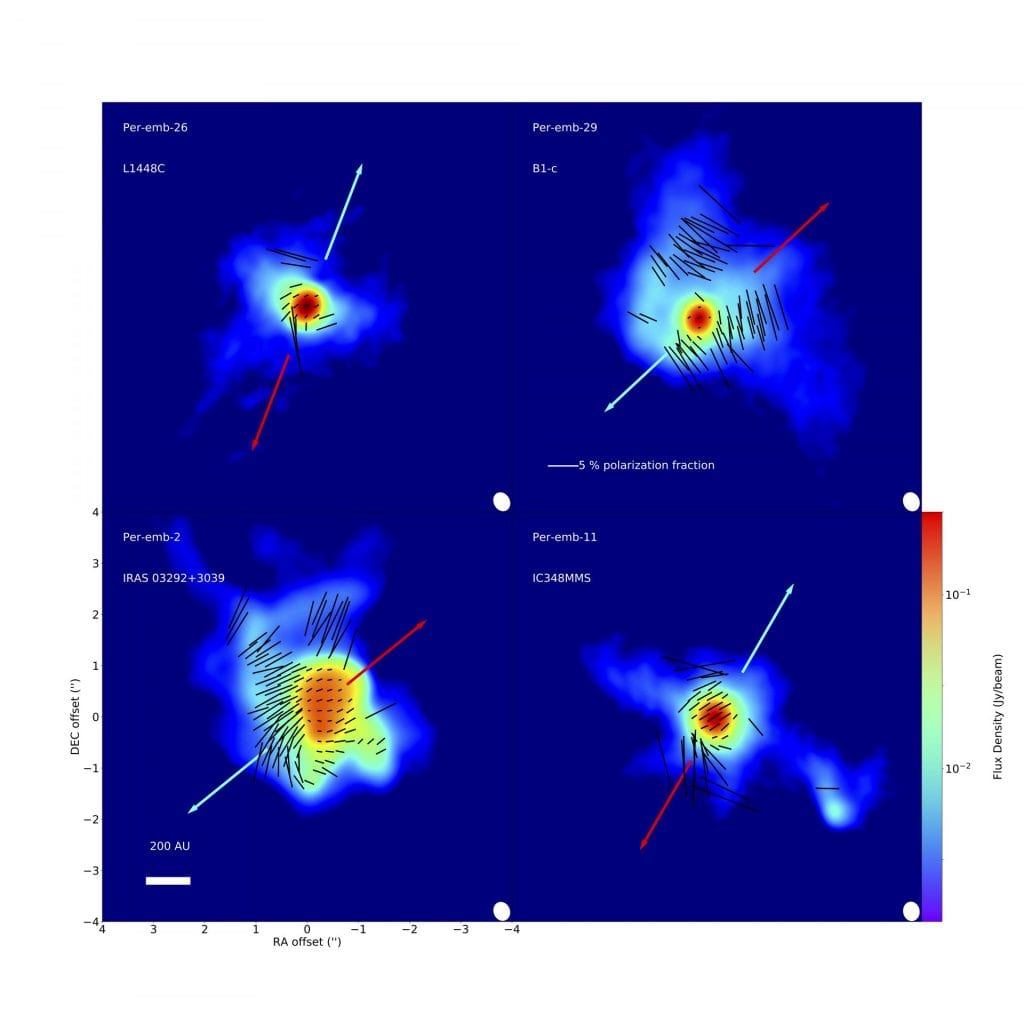Stars form from clouds of gas and dust. These clouds form filamentary structures where most young stars are found. When these filaments develop over-densities (likely due to some turbulent process), they begin their initial collapse to a hot core. These hot cores contain a large amount of angular momentum–so much, in fact, that the angular momentum should rip apart this object if it were to collapse further (i.e., into a protostar). However, we know that stars exist, so there must be a way to get rid of this excess angular momentum.
One way to do this is through magnetic braking. In-falling material can lose angular momentum via the field lines, if the local magnetic field has the right morphology and/or it is strong enough. While this helps solve one problem, magnetic braking creates an issue with disk growth in young protostars.
Disks are important to star and planet formation since they offer another way of angular momentum transport (at smaller and denser scales), and are the future sites of planet formation.
Magnetic fields in Class 0 sources
Using millimeter and sub-millimeter observations, we can observe the dust polarization signature in the youngest protostars (Class 0 sources). In the presence of a magnetic field, dust grains align their short axes to the field, and emit polarized thermal emission. We use these polarization measurements to infer the morphology of the plane-of-sky magnetic field. In Cox et al. 2015, we show the inferred magnetic field of a well-studied Class 0 protostar, NGC 1333 IRAS 4A. Using 8 mm VLA observations we find evidence of a magnetic field that is being wrapped as circumstellar material rotates around the central protostar.

BLAST-TNG is a balloon-borne telescope that is set to be launched from Antarctica late December 2018. This telescope will map out the magnetic fields in many clouds, ranging in distance and star formation activity. Using the larger scale magnetic field morphology allows us to make inferences on quantities such as the local star formation rate. We can use these observations as a theoretical check between what we observe as the magnetic field morphology on even larger scales (from telescopes such as Planck), to those on much smaller scales (from telescopes such as the VLA or ALMA). The results from these upcoming observations will provide us with the ability to start to make concrete claims as to the role magnetic fields play in the beginnings of star formation.
Polarization signatures in protostars
Multiple mechanisms can produce polarized emission. While we are likely tracing magnetically aligned dust grains in diffuse sources (such as the ISM, clouds, envelopes), polarized emission from denser regions may originate due to a different mechanism (e.g., scattering). In Yang et al. 2016, we model the VLA results and find that while scattering does produce some of the observed polarization, most of the emission is due dust grains aligned with magnetic fields.
This is likely due to the 8 mm emission being mostly optically thin. When we use shorter wavelengths, the emission can become optically thick, and scattering can add substantial contributions to the polarization signature. At sub-millimeter wavelengths, the protostar is not visible, so the scattering is from the disk itself. In Cox et al. 2018, we used ALMA 870 µm continuum observations to probe the polarization signature of 10 Class 0 protostars. We found evidence of scattering in the central regions of our candidate disks.

To determine the contribution scattering provides to this result (or to back out how much of the polarization is from magnetically aligned grains), we need followup observations using a different ALMA band. Stay tuned for this new data!
Structure of protoplanetary disks
The physical and chemical conditions of protoplanetary disks set the stage for planet formation. How much big and bright a disk is observed to be can be correlated to how massive it is, so we can set an upper limit to how massive its planets. Relatedly, we can study the chemical composition of these disks to learn about what types of planetary atmospheres these planets will have.
When a disk has depleted continuum emission, such as a transition or gapped disk, we often associate it with active planet formation. We are beginning to understand how we can study this structure seen at high-resolutions to relate it to how planets form. In Cox et al. 2017 we examine a survey of 49 pre-main-sequence stars in the Ophuichus cloud using ALMA 870 µm emission. We find 6 systems that show evidence of depleted continuum emission.
